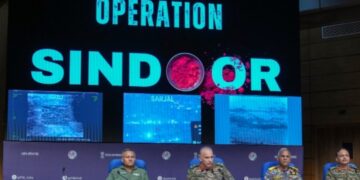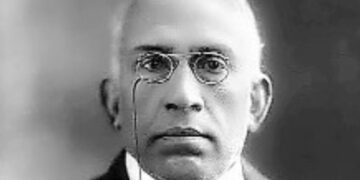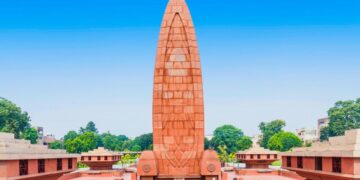The world is gearing up to witness the grandest of grand events on Jan 22 ahead of the Ram Temple consecration. The return of Shri Ram to his rightful abode after five centuries into exile has stirred profound emotions throughout the Universe.
While Ram Mandir has gotten wrapped in flowers illuminating ahead of mega Pran Pratistha, Ayodhya is going to see 10 lakh diyas lit across the city. The entire temple town is already in the grip of religious fervor as the ancient ‘Ayodhya Nagari’ has been tastefully decorated, especially the Ram Path and Dharm Path, the two street showpieces of what the government terms as the ‘Navya Divya and Bhavya’ Ayodhya” ..
The enchanting chant of ‘Jai Shree Ram’ has even resonated in the UK Parliament and reached countries like the US, Canada, and Australia, where millions are eagerly preparing to witness the grand ceremony through live streaming and religious observances.
Meanwhile, even though the Supreme Court’s definitive verdict on the Ram Mandir in 2019 evidently proved, ‘Ram wahi they aur isliiye wahin hain,’ there remains a segment that continues to cry foul or criticize this historic decision, which was rather taken on the fundamental basis of all legal actions. To address those false narratives, let us today take you through the roots of the big movement, the people who shaped it, and the stories that you might not have heard before.
Abundant evidences speak louder that Sri Ram temple in Ayodhya was demolished by the Mughal emperors and replaced by a mosque at the same location so be it archeological, documentary and iconological evidences.., the truth is the place rightly belonged to Shree Ram, Sabke Ram and that is why there is a universal acceptance of the fact that it was the birth-place of Shriram.
As in the words of Yogi Adityanath, the CM of UP “Dedicated efforts were made to realize the dream of the Ram Mandir for which the movement started in 1949”.
In 2019, when a historic Supreme Court judgment on the major dispute paved the way for the construction of the temple, Prime Minister Narendra Modi laid the foundation stone of Ram Mandir at Ayodhya. The five-judge bench said the faith of Hindus that Lord Ram was born at the site was undisputed, and he is symbolically the owner of the land. Following the inauguration of the first phase of the construction by Modi in 2020, Yogi Adityanath, the CM of UP, then laid the foundation stone for the ‘garbhagriha’ —sanctum sanctorum— of Ram Mandir in Jun 2022…marking the beginning of the next phase of construction of the main temple.
Even though it stands established beyond doubt that the idol of Ram Lalla which had been kept in a makeshift temple was the birthplace of Ram, there lies a long history that led to the Ram Mandir Movement. As the grand consecration of the Ram Temple approaches, it is crucial to shed light on certain narratives presenting a clear account of this centuries-old struggle with certain facts and figures.
As per several pieces of evidence, the re-establishment of the Ram Temple is rooted from the time after the first Mughal emperor Babar razed the iconic Ayodhya Ram temple to construct a mosque over it in the 16th century. Many academics and politicians as well as historical accounts establish that the mosque was built by Babur after demolishing a temple in Ayodhya, the capital of Rama’s father King Dashrath in the Ramayana. And that Babri Masjid was built in 1528 during the Mughal era by Mir Baqi, who was said to be a commander in the court of emperor Babur.
It was only in 2019 that the Supreme Court awarded the disputed site to Ram Lalla.
The Govt. of Bharat had asked both the parties to this dispute, to submit all the relevant historical proofs and documents, as to whether any Hindu temple was destroyed for the construction of Babari Masjid? Evidence meaning ‘human or material testimonials’, which clearly favored that there indeed, was a Hindu temple which was forcibly converted into a mosque; or alternatively, there was something other than a temple, say a vacant land; and the Mosque was constructed without any intervention into the then existing modes or systems of worship.
Timeline
As per another report, which rather provides some thoughtful data of the timeline of the Ayodhya legal dispute can be traced back to 1880s when the spot became a religious flashpoint between Hindus and Muslims which started with an alleged disputed in 1855 when Sunni Muslims claimed that the temple in nearby Hanumangarh was built after demolishing a mosque. The incident led to clashes between Muslims and Bairagis, at the end of which, it is believed that Wajid Ali Shah ruled in favor of the Hindus in the matter.
By 1859, the British government had erected a fence around Babri masjid amid a growing belief that the spot was the location of ‘Ram Janmabhoomi’, the birthplace of Lord Rama.
In 1885, what may be seen as one of the first pleas in the land dispute case, was filed in court in Faizabad by Mahant Raghubir Das. The plea, which sought permission for building a canopy outside the contested structure, was rejected.
Now comes an important day in terms of historic appearance of Ram Idol.
On December 23, 1949, when Ramlala’s appearance at Ayodhya’s Ram Janmabhoomi sparked widespread attention, thousands flocked to witness the idol under the disputed structure’s dome, which is believed to have manifested spontaneously. However, both the then central and state governments, led by Prime Minister Jawaharlal Nehru and Chief Minister Govind Vallabh Pant, decided to restore the situation to pre-December 22, 1949.
However, in 1950, a suit was filed in Faizabad district court by Gopal Simla Visharad seeking the right to worship the idol. Another petition to continue the worship and keep the idols was filed the same year by Paramahansa Ramachandra Das.
In 1959, the Nirmohi Akhara filed a suit seeking possession of the site. The suit is followed by another filed by UP Sunni Central Waqf Board in 1961 seeking possession of the site, says a report by wion news.
This politics, after a respite for about two decades, heated up once again in the latter half of the 80s after a local UP local court ordered the then Rajiv Gandhi-led Congress government to open the site for Hindu worshippers in 1986. The move led to religious tensions in UP, as anti-Hindu propaganda was formed into political and social spaces in the country. In August 1989, the Allahabad HC ordered a status quo in respect of the disputed structure.
The hearings later began in 2002 and In 2003, Supreme Court forbade religious activity of any nature inside the acquired land. In 2010, the court ruled in favor of a three-way division of the disputed area with a 2:1 majority and divided the Ram Janmabhoomi-Babri Masjid site into three parts, with Sunni Waqf board, Nirmohi Akhara, and Ram Lalla each receiving a third of it.
In 2011, the Allahabad HC verdict was stayed by the Supreme Court. In 2017, CJI JS Khehar suggested out-of-court settlement among rival parties. A three-judge bench was constituted by the Supreme Court the same year to hear the civil pleas against the 1994 Allahabad HC verdict. The hearings began the following year. In 2018, the Supreme Court reserved its verdict on the matter.
And In 2019, the Supreme Court set up a five-judge constitution bench to hear the title case. In the same year, the Centre moved the Supreme Court for permission to return the 67-acre acquired land around the disputed site to its original owners. The Supreme Court ruled that the case be mediated by a panel headed by former apex court judge FMI Kallifulla. Daily hearings in the case started after the failure of the mediation process in August 2019.
The historic decision of 2019 came when the supreme court ruled that the central dome of the demolished three-dome structure where the idol of Ram Lalla was kept in a makeshift temple is, indeed, “the place where Lord Ram was born”.
Construction
On November 9, Supreme Court granted all of the 2.77 acres of the land in Ayodhya to the deity Ram Lalla and also ruled that the possession of land will remain with the central government receiver. At the same time, the Centre and UP government were also directed to allot 5-acre land to the Muslims at a prominent place for building a mosque.
In 2020, a 15-Member Trust for Ram Temple in Ayodhya was announced in Parliament in 2020. Prime Minister Narendra Modi attended the Bhoomi Poojan at Ayodhya, commencing the temple construction on the previously disputed site.
Unraveling Historical Realities:
The core of all legal actions rests on the premise that a Sri Ram temple was historically demolished and replaced by a mosque at the same location. One notable instance is attributed to the rule of Mughal Emperor Aurangzeb, who ordered the temple’s demolition as a punitive measure, viewing it as a source of subversive ideas which led to the destruction of several temples, with mosques constructed in their place, as detailed by historian Satish Chandra.
The temple faced destruction on two earlier occasions, including an attack in 1194 CE by Aibak and another during Queen Raziya’s reign, resulting in the construction of a mosque. The temple was reconstructed during Akbar’s reign, only to face demolition again during Aurangzeb’s rule.
Interestingly, a section of the temple was intentionally preserved as the rear wall of the mosque, later known as the Gyanvapi Mosque.
Nonethless, after the years of struggle when the day has finally arrived, the historical victory of the devotees of Ram stands incomplete without mentioning the names of Former BJP leaders like LK Advani, Kalyan Singh, Uma Bharti, who played an indispensable role in this movement.
“The idea behind the ‘pradhan sankalp’ is that the ‘pratishtha’ of Lord Ram is being done for the welfare of all, for the welfare of the nation, for the welfare of humanity, and also for those who contributed to this work,” PTI quoted Arun Dixit as saying.
From LK Advani who started the Ram Mandir movement, to PM Modi who will finally inaugurate the temple in Ayodhya, the party leaders selflessly contributed and shaped the Ram MAndir Movement.
Meanwhile, Hindus worldwide are rejoicing over the fact that the idol of Ram Lalla was placed inside the sanctum sanctorum of the Ram temple in Ayodhya on Thursday, ahead of the Ram Janmabhoomi mandir ‘pran-pratishta’ ceremony on Monday. January 22. The 51-inch Ram Lalla idol, sculpted by Mysore resident, who has a family background of five generations of famous sculptors, was brought to the temple on Wednesday.
Ayodhya is being decked up to host the historic event as thousands of artisans, cultural performers are lodged in the city. More than 7,500 eminent guests including over 4,000 saints will be attending the grand ‘Pran Pratishtha’ of Lord Ram Lalla’s idol on Monday.
Prime Minister Narendra Modi will preside over the consecration ceremony on January 22, a landmark event that will fulfill the Bharatiya Janata Party’s core ideological promises and will likely be a key part of the party’s manifesto for the 2024 LoK Sabha polls.
Before we sign off, let us walk you through the mesmerizing #exclusive images of the decorated newly built Ram temple in Ayodhya released by The Shri Ram Janmabhoomi Teerth Kshetra Trust, ahead of the pran pratishtha ceremony as people can be seen giving final touches to the temple.
Jai shree Ram!
















Comments